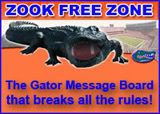Watch your back Herschel Walker
A review of the most recent SEC record book shows a number of new entries for Gator quarterback Tim Tebow after the 2007 season, including –
Yards Gained – Season
1. Tim Tebow - 4,181 (2007)
2. Tim Couch – 4,151 (1998)
Yards Per Game – Season
4. 341.7 – Tim Couch 1997
5. 321.6 – Tim Tebow 2007
6. 316.6 – Eric Zeier 1993
Touchdown Responsibility – Game
1. (several tied with 7, including) Tim Tebow, Florida v. South Carolina 2007
Touchdown Responsibility – Season
1. 55 – Tim Tebow 2007
2. 43 – Andre Woodson 2007
Most Touchdowns (not passing) – Season
1. 24 – Shaun Alexander 1999
2. 23 – Tim Tebow 2007
However, Tebow’s record that really intrigues me from 2007 was –
Touchdowns Rushing – Season
1. 23 –Tim Tebow 2007
2. 19 – Garrison Hearst 1992
_ 19 – Shaun Alexander 1999
_ 19 LeBrandon Toefield 2001
Which leads us to this –
Touchdowns Rushing - CAREER
1. 49— Herschel Walker, Georgia
2. 46— Kevin Faulk, LSU
3. 45— Carnell Williams, Auburn
4. 44— Dalton Hilliard, LSU
5. 43— Bo Jackson, Auburn
6. 41— Shaun Alexander, Alabama
_ 41— Darren McFadden, Arkansas
8. 40— Charles Alexander, LSU
9. 37— Deuce McAllister, Ole Miss
10. 36— Lars Tate, Georgia
_ 36— Emmitt Smith, Florida
12. 35— James Stewart, Tennessee
13. 34— Johnny Musso, Alabama
_ 34— Joe Cribbs, Auburn
_ 34— Errict Rhett, Florida
16. 33— Bobby Humphrey, Alabama
_ 33— Garrison Hearst, Georgia
_ 33— Earnest Graham, Florida
19. 32— Charles Trippi, Georgia
20. 31— Fred Taylor, Florida
_
31— Tim Tebow, FloridaYes young Tim, the ONLY active player on this list needs but 18 rushing touchdowns to become the all-time SEC leader in this category. Once again, this category is RUSHING TOUCHDOWNS.
Seeing as Tim scored 23 last year, the possibility exists that he could do it this season.
So here at Saurian Sagacity we are going to create a “countdown”, if you will, as Tim climbs the record book each week towards rushing touchdown immortality.
Charles Trippi of Georgia is up first with 32 career TD’s. On deck with 33 each are Bobby Humphrey of Alabama, Garrison Hearst of Georgia, and our own Earnest Graham.
Watch helplessly as ye sacred names of yore fall to The Chosen One, SEC rivals.















 Mentioned in Austin Murphy's book
Mentioned in Austin Murphy's book 

